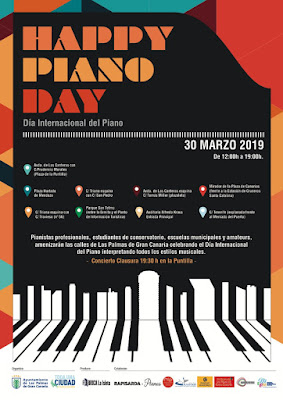Spring is here for real. A lot of free music outdoors — sometimes there are two or three worthwhile concerts the same day. Which one to choose?
- 11 April: Luis Suárez @ Teatro Guiniguada, Plaza F. Mesa de León, Las Palmas de Gran Canaria
- Luis Suárez gave an illuminating masterclass of electronic percussion. I wish his drumkit was positioned at the same level that audience though: in spite of me seating in the first row, I could hardly see what he was doing. Luckily, his laptop was projected to the big screen.
- 13 April: Althay Páez @ Parque Doramas
- I first saw Althay Páez almost seven years ago, performing at the Fuerteventura en Música festival. This time, he was accompanied by Jonay González Mesa (guitar), Johnny Olivares (percussion), Jairo Cabrera (brass and woodwind instruments) and Juanka González Trujillo (bass), with guest musician Julio Pereira (cavaquinho) and surprise appearance of Olga Cerpa.
- 15 April: Bach Brunch I @ Auditorio Alfredo Kraus, Avda. Príncipe de Asturias
- What, free music in Auditorio? Yes, as a part of the International Bach Festival Canarias there were two free concerts, at 12:30, half an hour each. Timur and I went to see both of them. The first one featured the Canarian pianist Evelia Rodríguez, who performed Bach’s English Suite No. 2 in A minor BWV 807 and Nocturne in E-flat major, Op. 55, No. 2 by Chopin. She played an encore too, I just don’t know what it was.
- 17 April: Bach Brunch II @ Auditorio Alfredo Kraus
- Canadian (not Canarian!) violinist Kerson Leong performed Bach’s Partita No. 3 in E major BWV 1006 and Sonata No. 2 “Jacques Thibaud” by Eugene Ysaÿe, plus a mindblowing version of Recuerdos de la Alhambra by Francisco Tárrega for an encore.
- 21 April: The Josés with Errol Woiski @ Clipper La Puntilla, Calle Caleta
- I saw The Josés almost a year ago and, sloppy repertoire notwithstanding, quite liked how they played. This Easter Sunday, Errol Woiski (vocals and guitar) joined them for some no-nonsense good old blues, so Timur and I also enjoyed what they played.
- 25—26 April: Muestra de escuelas de danza española @ Teatro Guiniguada
- I only attended the first evening of this showcase, on 25 April. It was free but you still need to get a ticket beforehand. I came to the theatre by 5 o’clock and joined the long queue. As far as I could see and hear, it was dominated by mums of young dancers. The lady in front of me told me that “somos seis” (“there’s six of us”). People were leaving the box office waving wads of tickets. Some of them just could not leave — they were coming back to see their friends and relations and instruct them to get more.
— Coño, chacha, tieneh muchah entradah. ¿Puedeh darme una?
I think I was the only one who asked for just one ticket. The show started at 20:30. Next to me there sat a granny holding an amazingly well-behaved baby. The programme was presented by Javier del Real. There were four schools of dance participating, including the school of the very Javier del Real and school of Elena Sánchez, plus a group of former students of Coca Navarro, and a great variety of dances: not just sevillanas and flamenco, but also classical ballet (bits of Don Quixote and Carmen Suite) and even one reggaeton number, with couple of really young dancers (I’d say, five- or six-year-olds).
— Mira niña, todavía no sé si vendrán la abuela y mi cuñada. - 27 April: Zenet @ Parque Doramas
- Until last Saturday, I was unaware of Toni Zenet (Málaga, 1967). The actor, singer and songwriter turned out to be so popular that, although I came well in advance, the venue (let’s call the seating area next to the stage that) was packed. And the audience knew the lyrics of his songs! Presenting his new album La Guapería, “the Andalusian crooner” was accompanied by Raúl Márquez (violin) and José Taboada (guitar).
- 28 April: AYWA @ Parque Doramas
-
Featuring Adil Smaali (lead vocals, ngoni, qraqeb), Damien Fadat (flute, keyboards, vocals), Damien Hilaire (drums, vocals), Guilhem Chapeau Centurion (bass guitar, vocals) and Théophile Vialy (guitar, vocals), AYWA play irresistibly catchy fusion of raï, jazz, rock and reggae with Balkan and Celtic influences.

AYWA caught in the act! 
More photos of AYWA @ Shutterstock - 29 April: Muestra de Danza Contemporánea @ Teatro Guiniguada
- More than 100 dancers from Canarias and beyond took place in this showcase on the International Dance Day. Among them, academies of Natalia Medina, Erre estudios, Carmen Cabrera, La Groove (Fuerteventura), Escuela municipal de danza de Candelaria (Tenerife), and NT estudios de danza. A bit of a mixed bag: some inventive examples of modern dance, including break dance, contemporary ballet, musical theatre, or even cabaret, interspersed with rather insipid Zumba-like routines set to reggaeton or hip-hop with explicit lyrics — sometimes I really wish the choreographers in this country knew English better.


















